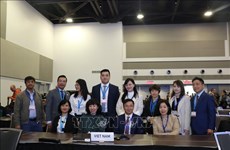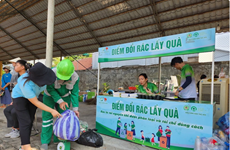Netherlands to increase climate change assistance for Vietnam
Rotterdam Mayor Ahmed Aboutaleb signed a memorandum of understanding
(MoU) to strengthen relations with Ho Chi Minh City in climate change
adaptation. The Dutch official spoke with Viet Nam News about the ties
between the two cities.
Rotterdam Mayor Ahmed Aboutaleb signed a memorandum of understanding
(MoU) to strengthen relations with Ho Chi Minh City in climate change
adaptation. The Dutch official spoke with Viet Nam News about the ties
between the two cities.
Q: Could you tell us about the new MoU between Rotterdam and HCM City and the status of the climate-change plan. What has been accomplished and what will be done in the years to come?
A: Rotterdam has been supporting HCM City since 2009 by sharing its own knowledge and experience regarding climate resilience, and in particular by helping HCM City develop an integrated Climate-Change Adaptation Strategy. Since 2013 Rotterdam has been helping the city to mainstream the key strategy principles into plans, procedures and projects and, very importantly, applying them to people.
The current phase of the partnership involves capacity-building of staff from relevant departments and districts. It also includes further detailing adaptation measures for specific districts. In the next phase of the cooperation, Rotterdam is offering help to find external funding for implementation of adaptation projects. It will also share its expertise on developing a Resilience Strategy, which includes, among other things, vulnerability assessments of vital infrastructure.
Q: How will the new agreement help combat the effects of climate change in Vietnam?
A: Rotterdam hopes to be able to help the city obtain more external funding for the implementation of adaptation measures. That way, implementation can be speeded up. Also, by sharing Rotterdam's lessons learned, HCM City can move more quickly, too.
Q: What are Vietnam's threats and priorities related to climate change?
A: Key threats and priorities are: rise in temperature, leading to higher temperatures in the city and deterioration of air and water quality; sea level rise, leading to increased flood risk and salt intrusion; change in precipitation, leading to increased nuisance from extreme rainfall; and change in river runoff, leading to an increase in flooding frequency. Please note that land subsidence is also a serious problem which is not climate change related, but does increase flood risks.
Q: Can you give us some outstanding examples of climate-change adaptation measures?
A: In Rotterdam we like to experiment with solutions that have as many benefits as possible and that can be fully integrated in our urban landscape. For example, we created the world's first water square that combines a playground with water storage. And a parking garage with an underground water basin. And a multifunctional levee, with shops at street level and a lovely park on the top of a floating conference center. I think the best solutions make the city more resilient and attractive at the same time. I believe HCM City has a lot of potential to become a unique climate-resilient delta city.
Q: How can we raise awareness of each individual's responsibility in tackling global problems?
A: The media can play a role in increasing awareness. Moreover, schools can play a role in educating children, who will then tell their parents. Another way is community involvement: by involving people in adaptation projects, they become more aware of the problems and may want to contribute themselves.-VNA
Q: Could you tell us about the new MoU between Rotterdam and HCM City and the status of the climate-change plan. What has been accomplished and what will be done in the years to come?
A: Rotterdam has been supporting HCM City since 2009 by sharing its own knowledge and experience regarding climate resilience, and in particular by helping HCM City develop an integrated Climate-Change Adaptation Strategy. Since 2013 Rotterdam has been helping the city to mainstream the key strategy principles into plans, procedures and projects and, very importantly, applying them to people.
The current phase of the partnership involves capacity-building of staff from relevant departments and districts. It also includes further detailing adaptation measures for specific districts. In the next phase of the cooperation, Rotterdam is offering help to find external funding for implementation of adaptation projects. It will also share its expertise on developing a Resilience Strategy, which includes, among other things, vulnerability assessments of vital infrastructure.
Q: How will the new agreement help combat the effects of climate change in Vietnam?
A: Rotterdam hopes to be able to help the city obtain more external funding for the implementation of adaptation measures. That way, implementation can be speeded up. Also, by sharing Rotterdam's lessons learned, HCM City can move more quickly, too.
Q: What are Vietnam's threats and priorities related to climate change?
A: Key threats and priorities are: rise in temperature, leading to higher temperatures in the city and deterioration of air and water quality; sea level rise, leading to increased flood risk and salt intrusion; change in precipitation, leading to increased nuisance from extreme rainfall; and change in river runoff, leading to an increase in flooding frequency. Please note that land subsidence is also a serious problem which is not climate change related, but does increase flood risks.
Q: Can you give us some outstanding examples of climate-change adaptation measures?
A: In Rotterdam we like to experiment with solutions that have as many benefits as possible and that can be fully integrated in our urban landscape. For example, we created the world's first water square that combines a playground with water storage. And a parking garage with an underground water basin. And a multifunctional levee, with shops at street level and a lovely park on the top of a floating conference center. I think the best solutions make the city more resilient and attractive at the same time. I believe HCM City has a lot of potential to become a unique climate-resilient delta city.
Q: How can we raise awareness of each individual's responsibility in tackling global problems?
A: The media can play a role in increasing awareness. Moreover, schools can play a role in educating children, who will then tell their parents. Another way is community involvement: by involving people in adaptation projects, they become more aware of the problems and may want to contribute themselves.-VNA













